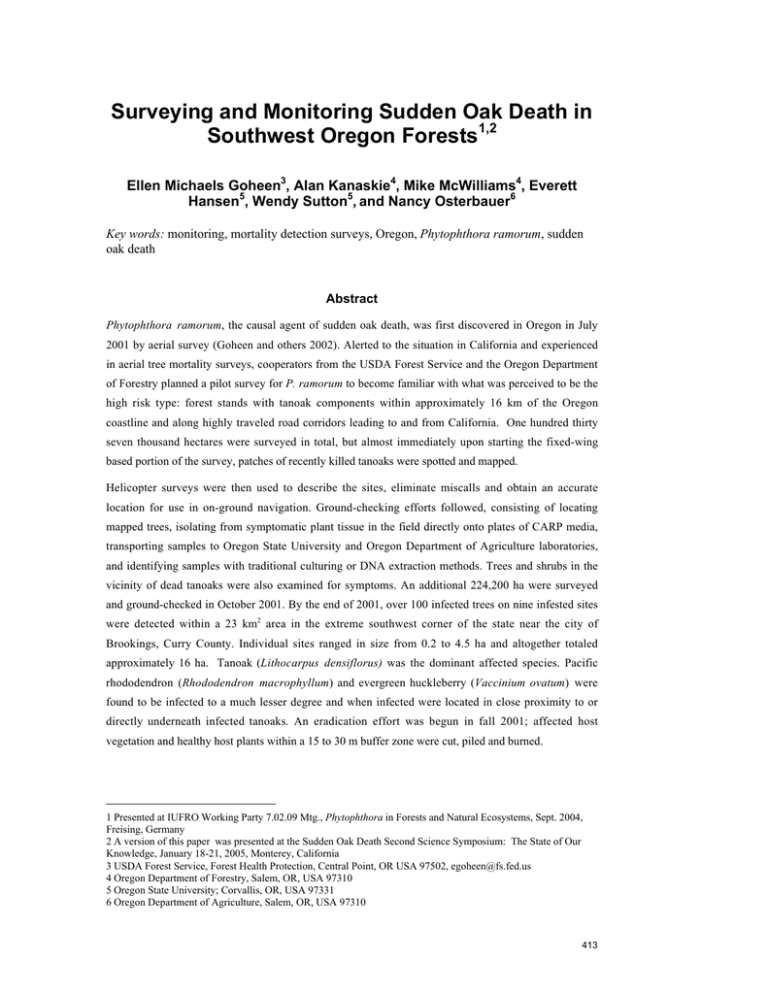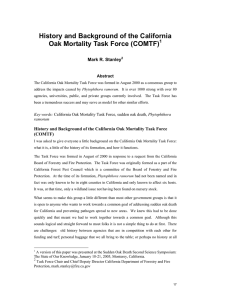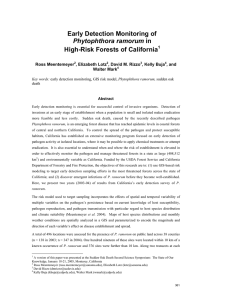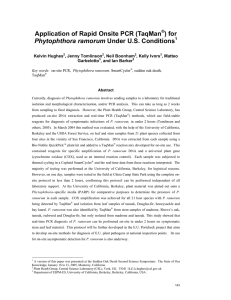Surveying and Monitoring Sudden Oak Death in Southwest Oregon Forests
advertisement

Surveying and Monitoring Sudden Oak Death in Southwest Oregon Forests1,2 Ellen Michaels Goheen3, Alan Kanaskie4, Mike McWilliams4, Everett Hansen5, Wendy Sutton5, and Nancy Osterbauer6 Key words: monitoring, mortality detection surveys, Oregon, Phytophthora ramorum, sudden oak death Abstract Phytophthora ramorum, the causal agent of sudden oak death, was first discovered in Oregon in July 2001 by aerial survey (Goheen and others 2002). Alerted to the situation in California and experienced in aerial tree mortality surveys, cooperators from the USDA Forest Service and the Oregon Department of Forestry planned a pilot survey for P. ramorum to become familiar with what was perceived to be the high risk type: forest stands with tanoak components within approximately 16 km of the Oregon coastline and along highly traveled road corridors leading to and from California. One hundred thirty seven thousand hectares were surveyed in total, but almost immediately upon starting the fixed-wing based portion of the survey, patches of recently killed tanoaks were spotted and mapped. Helicopter surveys were then used to describe the sites, eliminate miscalls and obtain an accurate location for use in on-ground navigation. Ground-checking efforts followed, consisting of locating mapped trees, isolating from symptomatic plant tissue in the field directly onto plates of CARP media, transporting samples to Oregon State University and Oregon Department of Agriculture laboratories, and identifying samples with traditional culturing or DNA extraction methods. Trees and shrubs in the vicinity of dead tanoaks were also examined for symptoms. An additional 224,200 ha were surveyed and ground-checked in October 2001. By the end of 2001, over 100 infected trees on nine infested sites were detected within a 23 km2 area in the extreme southwest corner of the state near the city of Brookings, Curry County. Individual sites ranged in size from 0.2 to 4.5 ha and altogether totaled approximately 16 ha. Tanoak (Lithocarpus densiflorus) was the dominant affected species. Pacific rhododendron (Rhododendron macrophyllum) and evergreen huckleberry (Vaccinium ovatum) were found to be infected to a much lesser degree and when infected were located in close proximity to or directly underneath infected tanoaks. An eradication effort was begun in fall 2001; affected host vegetation and healthy host plants within a 15 to 30 m buffer zone were cut, piled and burned. 1 Presented at IUFRO Working Party 7.02.09 Mtg., Phytophthora in Forests and Natural Ecosystems, Sept. 2004, Freising, Germany 2 A version of this paper was presented at the Sudden Oak Death Second Science Symposium: The State of Our Knowledge, January 18-21, 2005, Monterey, California 3 USDA Forest Service, Forest Health Protection, Central Point, OR USA 97502, egoheen@fs.fed.us 4 Oregon Department of Forestry, Salem, OR, USA 97310 5 Oregon State University; Corvallis, OR, USA 97331 6 Oregon Department of Agriculture, Salem, OR, USA 97310 413 GENERAL TECHNICAL REPORT PSW-GTR-196 Each year since 2001, continued systematic aerial surveys to detect tanoaks killed by P. ramorum have been conducted in early summer and mid autumn. Surveyed area has ranged from 90,000 to 150,000 ha using a risk-based approach to approximately 750,000 ha when covering the entire tanoak host type. Sites with dead tanoaks mapped from the air have increased from 41 in 2001, to 178, 292, and 307 in 2002, 2003, and 2004, respectively. In most years 100 percent of all mapped dead tanoaks have been visited and evaluated; difficulty accessing trees due to steep, rugged terrain has made visiting a few of the mapped trees impossible in some years. The number of P. ramorum-infected tanoaks confirmed each year has decreased since the initial detection of the pathogen from 85 to 48 to 36 in 2002, 2003, and 2004, respectively. A total of approximately 24 ha within a 30 km2 area are considered infested as of September 2004. P. ramorum is not the only agent associated with tanoak mortality in southwestern Oregon forests (Hansen and others 2003). Other mortality agents identified include P. nemorosa, Armillaria mellea, A. gallica, herbicides and mechanical damage. P. nemorosa causes bleeding symptoms quite similar to P. ramorum, making field diagnosis challenging. It is most often associated with widely scattered, single tree mortality. Armillaria species are found on trees with obvious Phytophthora-caused cankers as well as on trees with no evidence of Phytophthora infection. In the course of ground-checking aerial surveys and monitoring eradication treatments, new hosts for P. ramorum were found and described. These include poison oak (Toxicodendron diversiloba) with visible bleeding and necrotic phloem symptoms typical of P. ramorum’s oak and tanoak hosts, and salmonberry (Rubus spectabilis) and cascara (Rhamnus purshiana), both foliar hosts with watersoaked leafspots (Davidson and others 2003). Detecting P. ramorum from the air is nearly impossible when oak mortality is not visible or when P. ramorum-caused symptoms are restricted to leafspots and twig blights in understory species. Groundbased surveys for P. ramorum have been done in many areas within the known host type. These include roadside transect surveys designed to detect P. ramorum on leafspot and twig dieback hosts, surveys designed for early detection of P. ramorum within the host type but outside of known disease areas, transect surveys of host vegetation targeted along popular trails and in high-use campgrounds near the Winchuck and Chetco Rivers, and extensive watershed-level monitoring inside and outside the regulated area by baiting streams with tanoak and rhododendron leaves. In Oregon forests, new, positive P. ramorum finds have almost always resulted from either aerial detection surveys or eradication treatment perimeter plots and reconnaissance; P. ramorum has not been detected outside of known infested areas in either roadside or targeted ground surveys. It has been recovered from most streams draining infested sites, was recovered once from a stream within the affected area but not associated with a known infested site, and has never been recovered from monitored streams outside of the generally infested area. Searching for P. ramorum in forest settings is challenging. Success associated with detecting P. ramorum in Oregon’s tanoak forests is due to many factors. Funding for early detection is readily available. Experienced aerial surveyors work with the latest mapping technology. Cooperating field crews from several agencies and laboratories are committed to timely ground checking and sample processing. Landowners have given access to their properties for ground checking, treatment and 414 Proceedings of the sudden oak death second science symposium: the state of our knowledge monitoring. In Oregon, P. ramorum primarily affects tanoaks, therefore, recently killed tanoaks can be used to indicate the most likely areas of disease. Despite new occurrences of P. ramorum, distribution of the pathogen remains limited to a relatively small area in Curry County. Surveys as described in this paper will be continued in both the known affected area and across the ranges of the host species. References Davidson J.M.; Werres S.; Garbelotto M.; Hansen E.M.; and Rizzo D.M., 2003. Sudden oak death and associated diseases caused by Phytophthora ramorum. Plant Health Progress On-line doi:10.1094/PHP-2003-0707-01-DG. Goheen E.M.; Hansen E.M.; Kanaskie A.; and McWilliams M.G., 2002. Sudden Oak Death caused by Phytophthora ramorum in Oregon. Plant Disease 86:441. Hansen E.M.; Reeser P.W.; Davidson J.M.; Garbelotto M.; Ivors K.; Douhan L.; and Rizzo D.M., 2003. Phytophthora nemorosa, a new species causing cankers and leaf blight of forest trees in California and Oregon, U.S.A. Mycotaxon 88: 129 - 138. 415







